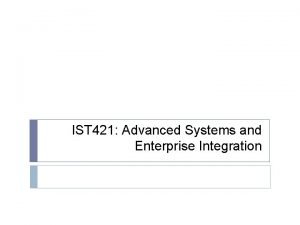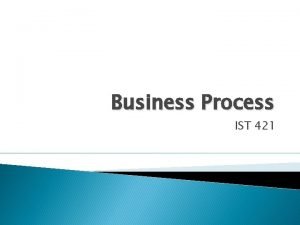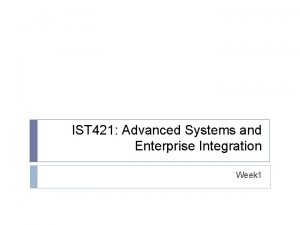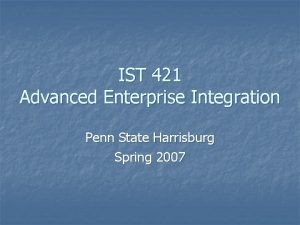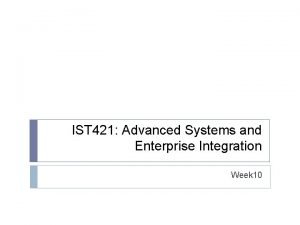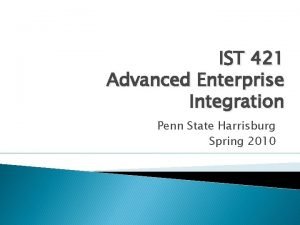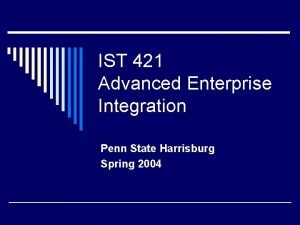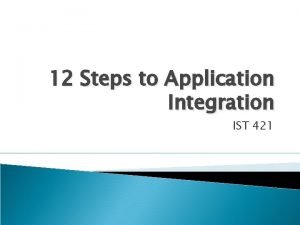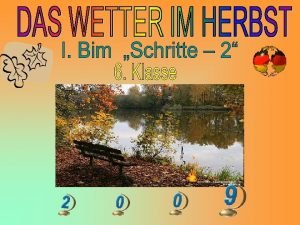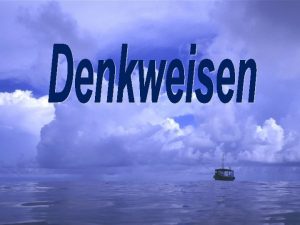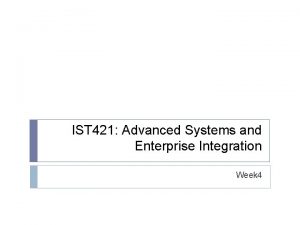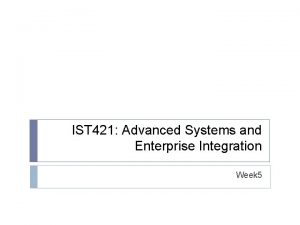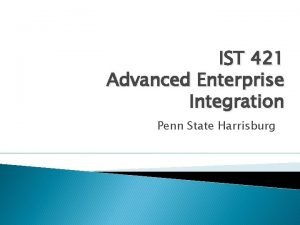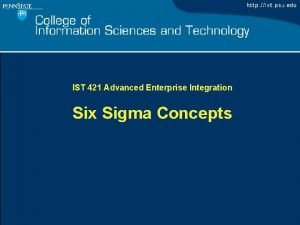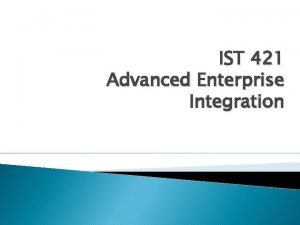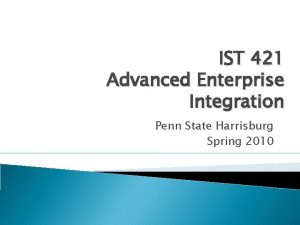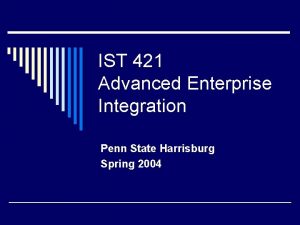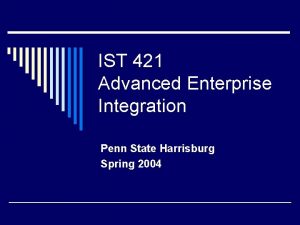IST 421 Advanced Systems and Enterprise Integration Week















- Slides: 15

IST 421: Advanced Systems and Enterprise Integration Week 9

Quick Reminders � Next � project deliverable is Preliminary Design Document Section IV. System Design and Prototype” � Both PDD and DDD will fill in the same section of the template in two iterations � Do not be deceived by the small size of the section as it appears in the template! There is lot of critical input required in this section � Common observations in project deliverables Update ‘Update Control’ section in the template � Too much reliance on text…. Remember design is all about modeling! �

EI Roadmap Source: GBR, 2005, p. 18

Application Integration � Interoperability: ability to combine and share information across system and organizational boundaries Reaction to received message, conversation rules Levels of interoperability Representation of messages • Format • Structure • Semantics (e. g. purchase order, error message, print command) Communication infrastructure: channels and models • Delivery (direct/indirect) • Trigger (event/schedule) • Response (asynchronous / synchronous) • Activation (push/pull) Source: Sherif pp. 356 -357

2. XML An Example Trigger: event Delivery: P 2 P / Broker Response: Synchronous Activation: Push Customer Credit Validator (SAP) Customer name: John Customer ID: 123 Products ordered Shoes: 1 pair $55. 00 Shirt: 2 … $35. 00 3. Credit accepted / rejected Customer DB (Relational DB) ETL Trigger: schedule Delivery: P 2 P / Broker Response: Asynchronous Activation: Pull Customer IDs, Order Nos. Credit status, Accept/Reject 1. Purchase order Shop. com (Custom webapp) r rde / O. 4 ed ept c c a cted reje XML files Weekly Summary Report (Dashboard app) Data Warehouse (Star schema) XML Trigger: schedule Delivery: P 2 P / Broker Response: Asynchronous Activation: Pull Customer IDs, Order Nos. , Products ordered, Order values, Shipping locations, etc.

Application Integration � Heterogeneity problem � Two strategies to address heterogeneity problems � Integration: Differences between existing software parts bridged using middleware � Standardization: For development of new systems or services

EAI � Hub-and-spoke 1. 2. 3. 4. topology Adapters extract data from application and send to hub Transformers convert data to required format Routers route data to communication channel Channel message delivered to application (HTTP, SMTP, etc. )

SOA � Bus topology � � Services: interface and implementation Service bus: Messaging infrastructure for service discovery and activation Orchestration engine: Control flow among services. Abstract process models are designed and linked to services Registry: Where services are published

EAI vs. SOA � EAI � � � Easy to manage, but …hub quickly gets overloaded, doesn’t scale very well. Federated hub-and-spoke may help. Offers technical flexibility SOA � � Message transformation and routing is distributed in the application adapters … so scales well. Offers loose coupling and autonomy --- business flexibility

Reference Architectures � An aggregated view of all the integration patterns into a fully integrated infrastructure (see GBR, p. 264) � Application Integration � Message broker � ESB � Mobile server Information Integration � � Results of integration Mobile integration � Connectivity with partners (B 2 B connectivity: EDI, Web-services, FTP etc. ; B 2 B Server; B 2 B Exchange, etc. ) Portals � Connectivity with mainframe applications (Interfaces for messaging, screens / reports, services, etc. ) B 2 B integration � Distributed service-based connectivity (services, service, bus, orchestration, registry) Legacy integration � Centralized or federated message-based connectivity (adapters, routers, transformers, channels. ) Replication / synchronization, Data Cleansing, Transaction management, Structured / Unstructured content, Metadata repository, etc. Process Integration � BPM, Process and rules engine, Business Activity monitoring, etc.

Example: AS-IS Architecture Source: http: //www. redbooks. ibm. com/redpapers/pdfs/redp 4467. pdf

Example: Reference Architecture Source: http: //www. redbooks. ibm. com/redpapers/pdfs/redp 4467. pdf

Application Integration Platforms Magic Quadrant for On-Premises Application Integration Suites Application Integration Platform Examples: • IBM Web. Sphere • Microsoft Biz. Talk • Oracle Fusion Middleware • Red. Hat JBoss • SAP Net. Weaver • Software AG Web. Methods Source: www. gartner. com

Application Integration Technologies Application Integration Infrastructure Market, Worldwide (2011 -2018) Source: www. gartner. com

Conclusions � EAI � � SOA � � � Technology focused Helps reuse of existing systems Centralized or federated architecture Business focused Needs standardization Helps in business-IT alignment Distributed architecture Best Practices � � Invest in reuse Avoid or reduce redundancy Minimize the impact of change Use standards wherever practical
 Ist 421
Ist 421 Ist 421
Ist 421 Ist 421
Ist 421 Ist 421
Ist 421 Advanced systems integration
Advanced systems integration Ist 421
Ist 421 Ist 421
Ist 421 Ist 421
Ist 421 Week by week plans for documenting children's development
Week by week plans for documenting children's development Winter kommt winter kommt flocken fallen nieder lied
Winter kommt winter kommt flocken fallen nieder lied Winter kommt winter kommt flocken fallen nieder
Winter kommt winter kommt flocken fallen nieder Es ist herbst bunte blätter fliegen
Es ist herbst bunte blätter fliegen Es ist herbst bunte blätter fliegen
Es ist herbst bunte blätter fliegen Zu glauben ist schwer. nichts zu glauben ist unmöglich
Zu glauben ist schwer. nichts zu glauben ist unmöglich Three dimensions of corporate strategy
Three dimensions of corporate strategy Forward integration and backward integration
Forward integration and backward integration
